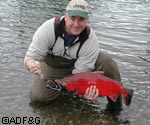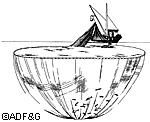Alaska Fish & Wildlife News
April 2005
An Alaska Buffalo Hunt

The three bison were all big, but one shaggy bull dusted with snow stood out. Hunter Travis Smith, 14, knelt and rested the heavy octagon barrel of his buffalo rifle on a shooting stick, then took aim at a 1,200-pound Alaska buffalo.
A herd of about 400 wild, free-ranging plains bison roams the countryside near Delta Junction in Interior Alaska. About 16,000 hunters apply each year for the chance to hunt these massive beasts, and only 130 people received permits last year. Smith was one ...
Alaska Buffalo Hunt ArticleContinued
Eyes of the Bear
Bears See Well, but Trust Noses More

There are a lot of misconceptions about bears. “Grizzly bears can’t climb trees,” or “bears can’t run downhill” – both untrue. One common misconception is that bears have poor eyesight. The reasons behind this misconception are understandable, but evidence indicates that bears’ eyesight is comparable to ours.
“From my experience bears can see very well at a distance, at least as well as humans,” said biologist Harry Reynolds. Reynolds ... Bears' Vision Article Continued
Testing Bears’ Color Vision

Tests with black bears and polar bears indicate that bears can see color.
Researchers Ellis Bacon and Gordon Burghardt of the University of Tennessee concluded that black bears could discriminate between shades of color. Two bears were trained to associate food with a specific color: one bear learned that food was in a blue container, the other identified green. Containers were tightly sealed to prevent olfactory clues.
After learning to associate food with color, bears were ...
Do Bears See Color? ArticleContinued
The Poor Man’s Lobster of the Tanana Valley
Burbot

The first burbot I ever saw was preserved in a bottle of formaldehyde. It was the same monotone, gray-brown color of the dozens of specimens in jars that had come before it. I was unimpressed. It's hard to have much feeling for something that smells that putrid and looks that bad. Not only that, I was cramming for an ichthyology exam and didn't have time for the luxury of appreciation.
A year or two later, I tagged along with a friend to check his burbot setlines on the Tanana River ...
Burbot ArticleContinued
Coho in the Delta Clearwater River

As we boat upstream on the Delta Clearwater River, the fog is thick and the sound of the motor echoes back from the branches heavy with frost. As we weave our way up to the head of the river to begin our coho count we pass over riffles and pools where darting salmon move off their nests (redds) in numbers that I have not seen in 20 years. Today, the 21st of October, we will count nearly 103,000 salmon over 17 ½ miles of river.
Dave Davenport, an Alaska Department of Fish & Game Fish and ...
Delta Coho ArticleContinued
"Orphaned" Animals
Editorial

As spring draws near and the wilds of Alaska emerge from a long winter, the Alaska Department of Fish and Game prepares for the upcoming orphaned wildlife season. The Division of Wildlife Conservation is responsible for managing all game animals in Alaska, and every year the division is confronted with calls about orphaned baby animals.
Dealing with orphaned wildlife is a difficult and emotionally charged situation. People's opinions vary greatly on issues of letting nature run its course ...
"orphaned" animals ArticleContinued
What Kind of Fishing Boat is That?
Know your Commercial Fishing Boats, Pt. 1

Purse Seiner –
Purse seiners catch salmon (primarily pink salmon) and herring by encircling them with a long net and drawing (pursing) the bottom closed to capture the fish. The net is first stacked on the stern of the boat and then paid into the water while the boat travels in a large circle around the fish. The far end of the net is attached to a power skiff, which helps the operation by holding the net while the seiner completes the circle.
The top of the net stays on the surface ...
Know your Boats ArticleContinued
What Kind of Fishing Boat is That? Pt. 2
Trawler, longliner & gillnetter

Trawler –
Trawlers are sometimes confused with trollers due to their similar sounding names, but there are few similarities. Trawlers typically catch large quantities of midwater species, such as pollock or pink shrimp, and bottomfish, such as flounder, by towing a large, cone-shaped net. Most trawl nets have “doors” on either side of the net's opening to help hold it open, and some that are fished near the bottom have a heavy chain strung along the bottom of the opening to hold it close ...
Know Your Boats ArticleContinued
